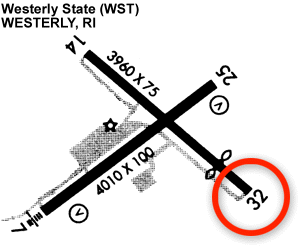Never assume, always look around
(NYC04FA033B)
 Maintaining a good lookout while in the traffic pattern is imperative. On November 16, 2003, a Piper Archer and a Cessna Skywagon collided over Runway 32 at Rhode Island's Westerly Airport. The Cessna was taking off while the Piper was landing. No one aboard the Piper was injured, but the two flight instructors aboard the Cessna were killed.
Maintaining a good lookout while in the traffic pattern is imperative. On November 16, 2003, a Piper Archer and a Cessna Skywagon collided over Runway 32 at Rhode Island's Westerly Airport. The Cessna was taking off while the Piper was landing. No one aboard the Piper was injured, but the two flight instructors aboard the Cessna were killed.
According to the pilot of the Piper, this was his second approach of the day to Runway 32. He had decided to go around on the first landing attempt because he was too high. The Piper pilot continued on a left hand traffic pattern for Runway 32 and announced each leg over the CTAF. When he turned to the final approach leg for landing, he noticed a tailwheel airplane about to taxi onto Runway 32. It remained in the displaced threshold area of the runway, so the Piper pilot assumed that it would remain there until after he landed.
As he passed over the threshold, he heard the sound of another airplane engine and felt something hit his plane. The Piper touched down hard on the runway, skidded, and came to rest upright on the taxiway. After the impact, witnesses saw the Cessna pitch up, nose over, then hit the ground. Another pilot in the pattern for Runway 25 heard the Piper's radio transmissions, but did not hear any from the Cessna.
During the investigation it was found that the trees parallel to Runway 32's taxiway obscured aircraft flying left traffic patterns for the runway. Traffic was not visible to a person facing southeast until the traffic turned on final approach.
The NTSB determined the probable cause of this accident to be the Piper pilot's improper decision to continue a landing on an occupied runway, which resulted in an in-flight collision with the departing Cessna. Factors included the Cessna pilot's inattentive radio communications, and the obscured visibility of the traffic pattern from the air and ground by trees located at the departure end of the runway.
Although FAR 91.113 states that landing aircraft or aircraft on final approach landing have the right-of-way over aircraft that are in-flight or operating on the ground, there were extenuating circumstances in this case. The pilot of the Cessna may not have seen the Piper, and once he took position on the runway, he could not see the aircraft approaching him from behind. At that point, the pilot of the Piper should have given way and gone around.
For more information about operating safely in the airport environment, take the AOPA Air Safety Institute's online course, Runway Safety, or read Safety Advisors about Operations at Nontowered Airports and Collision Avoidance.
Accident reports can be found in ASI's accident database.